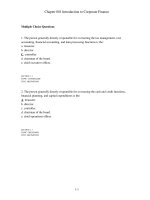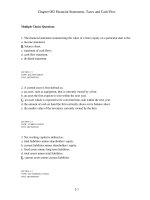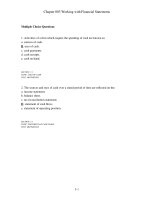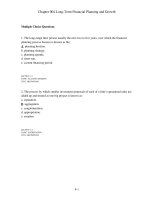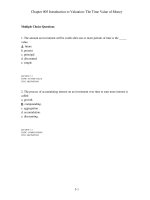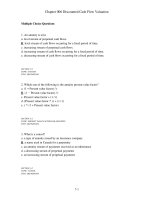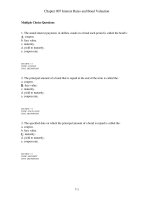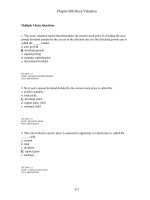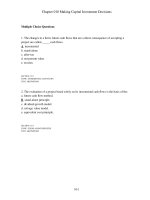Test bank corporate finance 8e ros chap009
Bạn đang xem bản rút gọn của tài liệu. Xem và tải ngay bản đầy đủ của tài liệu tại đây (874.19 KB, 72 trang )
Chapter 009 Net Present Value and Other Investment Criteria
Multiple Choice Questions
1. The difference between an investment's market value and its cost is the:
A. net present value.
b. internal rate of return.
c. payback period.
d. profitability index.
e. discounted payback period.
SECTION: 9.1
TOPIC: NET PRESENT VALUE
TYPE: DEFINITIONS
2. The process of valuing an investment by determining the present value of its future cash
flows is called:
a. the constant dividend growth model.
B. discounted cash flow valuation.
c. average accounting valuation.
d. the expected earnings model.
e. the Capital Asset Pricing Model.
SECTION: 9.1
TOPIC: DISCOUNTED CASH FLOW VALUATION
TYPE: DEFINITIONS
3. The length of time required for an investment to generate cash flows sufficient to recover
the initial cost of the investment is called the:
a. internal rate of return.
B. payback period.
c. profitability index.
d. discounted cash period.
e. net present value.
SECTION: 9.2
TOPIC: PAYBACK PERIOD
TYPE: DEFINITIONS
9-1
Chapter 009 Net Present Value and Other Investment Criteria
4. The length of time required for a project's discounted cash flows to equal the initial cost of
the project is called the:
a. net present value.
b. internal rate of return.
c. payback period.
d. discounted profitability index.
E. discounted payback period.
SECTION: 9.3
TOPIC: DISCOUNTED PAYBACK PERIOD
TYPE: DEFINITIONS
5. An investment's average net income divided by its average book value defines the average:
a. net present value.
b. internal rate of return.
C. accounting return.
d. profitability index.
e. payback period.
SECTION: 9.4
TOPIC: AVERAGE ACCOUNTING RETURN
TYPE: DEFINITIONS
6. The discount rate that makes the net present value of an investment exactly equal to zero is
called the:
a. external rate of return.
B. internal rate of return.
c. average accounting return.
d. profitability index.
e. equalizer.
SECTION: 9.5
TOPIC: INTERNAL RATE OF RETURN
TYPE: DEFINITIONS
9-2
Chapter 009 Net Present Value and Other Investment Criteria
7. The possibility that more than one discount rate will make the NPV of an investment equal
to zero is called the _____ problem.
a. net present value profiling
b. operational ambiguity
c. mutually exclusive investment decision
d. economies of scale
E. multiple rates of return
SECTION: 9.5
TOPIC: MULTIPLE RATES OF RETURN
TYPE: DEFINITIONS
8. A situation in which accepting one investment prevents the acceptance of another
investment is called the:
a. net present value profile.
b. operational ambiguity decision.
C. mutually exclusive investment decision.
d. economies of scale decision.
e. multiple choices of operations decision.
SECTION: 9.5
TOPIC: MUTUALLY EXCLUSIVE INVESTMENT DECISION
TYPE: DEFINITIONS
9. The present value of an investment's future cash flows divided by the initial cost of the
investment is called the:
a. net present value.
b. internal rate of return.
c. average accounting return.
D. profitability index.
e. profile period.
SECTION: 9.6
TOPIC: PROFITABILITY INDEX
TYPE: DEFINITIONS
9-3
Chapter 009 Net Present Value and Other Investment Criteria
10. Capital budgeting decisions generally:
A. have long-term effects on a firm.
b. are of short-duration.
c. revolve around the decision to use either debt or equity securities to finance a project.
d. focus solely on whether or not a particular asset should be purchased.
e. have minimal effects on a firm's operations.
SECTION: CHAPTER 9 INTRODUCTION
TOPIC: CAPITAL BUDGETING DECISIONS
TYPE: CONCEPTS
11. Which one of the following is a capital budgeting decision?
a. deciding whether a bank loan should be secured or if bonds should be issued
b. determining how many bonds versus how many shares of stock should be issued
c. ascertaining the minimum amount of cash which should be kept on hand
d. determining the optimal level of inventory to be maintained
E. deciding whether or not a newly invented product should be produced
SECTION: CHAPTER 9 INTRODUCTION
TOPIC: CAPITAL BUDGETING DECISIONS
TYPE: CONCEPTS
12. Which one of the following will increase the net present value of a project?
a. an increase in the discount rate
b. decreasing the amount of each cash inflow
c. increasing the amount of the initial cash outflow
D. decreasing the required rate of return
e. having all incoming cash flows occur in the final year of a project rather than periodically
over a five-year period
SECTION: 9.1
TOPIC: NET PRESENT VALUE
TYPE: CONCEPTS
9-4
Chapter 009 Net Present Value and Other Investment Criteria
13. A project creates value for a firm's owners:
A. when the net present value of the project is positive.
b. any time the cash inflows exceed the cash outflows.
c. whenever the internal rate of return is less than the required return.
d. whenever the profitability index is less than one.
e. whenever the payback period exceeds the life of the project.
SECTION: 9.1
TOPIC: NET PRESENT VALUE
TYPE: CONCEPTS
14. If a project has a net present value equal to zero, then:
a. the present value of the cash inflows must exceed the initial cost of the project.
b. the project produces a rate of return in excess of the required return.
c. the project is expected to produce cash inflows in an amount equal to the initial cash
outflow.
D. any delay in receiving the projected cash inflows will cause the project to have a negative
net present value.
e. the cash inflows equal the project's initial cost given a positive discount rate.
SECTION: 9.1
TOPIC: NET PRESENT VALUE
TYPE: CONCEPTS
15. When computing the net present value of a project, the net amount received from
salvaging the fixed assets used in the project is:
a. subtracted from the initial cash outlay.
B. included in the final cash flow of the project.
c. excluded from the analysis since it occurs only when the project ends.
d. subtracted from the original cost of the assets.
e. added to the net present value computed based on the other cash flows.
SECTION: 9.1
TOPIC: NET PRESENT VALUE
TYPE: CONCEPTS
9-5
Chapter 009 Net Present Value and Other Investment Criteria
16. Net present value:
a. when applied properly, can accurately predict the cash flows that will occur if a project is
implemented.
b. is highly independent of the rate of return assigned to a particular project.
C. is the preferred method of analyzing a project even though the cash flows are only
estimates.
d. is unaffected by the timing of each and every cash flow related to a project.
e. is unaffected by the timing of the purchase of the fixed assets required for a project.
SECTION: 9.1
TOPIC: NET PRESENT VALUE
TYPE: CONCEPTS
17. Net present value:
A. should be used when deciding between two mutually exclusive projects.
b. is less useful than the internal rate of return when comparing different sized projects.
c. is easy to explain to non-financial, low-level managers.
d. is less useful than the profitability index when comparing mutually exclusive projects.
e. is very similar in its methodology to the average accounting return.
SECTION: 9.1
TOPIC: NET PRESENT VALUE
TYPE: CONCEPTS
18. A project is acceptable when the net present value:
a. is negative.
B. is positive.
c. is negative provided the only cash outflow occurs at time zero.
d. is positive provided the internal rate of return is less than the required return.
e. is positive provided the profitability index is less than one.
SECTION: 9.1
TOPIC: NET PRESENT VALUE
TYPE: CONCEPTS
9-6
Chapter 009 Net Present Value and Other Investment Criteria
19. Payback is frequently used to analyze independent projects because:
a. it considers the time value of money.
b. all relevant cash flows are included in the analysis.
C. the cost of the analysis is less than the potential loss from a faulty decision.
d. it is the most desirable of the various financial methods of analysis.
e. it is focused on the long-term impact of a project.
SECTION: 9.2
TOPIC: PAYBACK
TYPE: CONCEPTS
20. The advantages of the payback method of project analysis include the:
I. application of a discount rate to each separate cash flow.
II. bias towards liquidity.
III. ease of use.
IV. arbitrary cutoff point.
a. I and II only
b. I and III only
C. II and III only
d. II and IV only
e. II, III, and IV only
SECTION: 9.2
TOPIC: PAYBACK
TYPE: CONCEPTS
21. According to the payback rule, a project is acceptable when the payback period is:
a. less than the discounted period.
b. equal to or greater than the prespecified period.
c. positive and greater than the prespecified period.
d. either negative or equal to zero.
E. is less than the prespecified period.
SECTION: 9.2
TOPIC: PAYBACK
TYPE: CONCEPTS
9-7
Chapter 009 Net Present Value and Other Investment Criteria
22. A project has a required payback period of three years. In this case, the:
a. cash flows in each of the three years must exceed one-third of the project's initial cost.
b. cash flow in year three is ignored.
c. project's initial cost is discounted.
D. cash flow in year two is valued just as highly as the cash flow in year one.
e. project is acceptable whenever the payback period exceeds three years.
SECTION: 9.2
TOPIC: PAYBACK
TYPE: CONCEPTS
23. All else equal, the payback period for a project will decrease whenever the:
a. initial cost increases.
b. required return for a project increases.
c. assigned discount rate decreases.
D. cash inflows are adjusted such that they occur sooner.
e. duration of a project is lengthened.
SECTION: 9.2
TOPIC: PAYBACK
TYPE: CONCEPTS
24. Discounted payback is used less frequently than payback because:
a. the methodology is less desirable from a financial perspective.
b. it is simpler to calculate.
c. it requires an arbitrary cutoff point.
d. it is biased towards liquidity.
E. it includes time value of money calculations.
SECTION: 9.3
TOPIC: DISCOUNTED PAYBACK
TYPE: CONCEPTS
9-8
Chapter 009 Net Present Value and Other Investment Criteria
25. The discounted payback period of a project will decrease whenever the:
a. discount rate applied to the project is increased.
b. initial cash outlay of the project is increased.
c. number of cash inflows is increased.
D. amount of each cash inflow is increased.
e. costs of the fixed assets utilized in the project increase.
SECTION: 9.3
TOPIC: DISCOUNTED PAYBACK
TYPE: CONCEPTS
26. The discounted payback rule may cause:
A. some positive net present value projects to be rejected.
b. the most liquid projects to be rejected in favor of less liquid projects.
c. projects to be incorrectly accepted due to ignoring the time value of money.
d. projects with negative net present values to be accepted.
e. some projects to be accepted which would otherwise be rejected under the payback rule.
SECTION: 9.3
TOPIC: DISCOUNTED PAYBACK
TYPE: CONCEPTS
27. The average accounting rate of return:
a. considers the time value of money.
b. measures net income as a percentage of the sales generated by a project.
c. is the best method of analyzing mutually exclusive projects from a financial point of view.
d. is the primary methodology used in analyzing independent projects.
E. is similar to the return on assets ratio.
SECTION: 9.4
TOPIC: AVERAGE ACCOUNTING RETURN
TYPE: CONCEPTS
9-9
Chapter 009 Net Present Value and Other Investment Criteria
28. Assuming that straight line depreciation is used, the average accounting return for a
project is computed as the average:
a. net income of a project divided by the average total assets of a firm.
b. book value of a project multiplied by the average profit margin of the project.
c. book value of a project divided by the average net income of the project.
D. net income of a project divided by the average investment in the project.
e. net income of the firm divided by the average investment in a project.
SECTION: 9.4
TOPIC: AVERAGE ACCOUNTING RETURN
TYPE: CONCEPTS
29. Which one of the following is an advantage of the average accounting return?
A. general ease of obtaining the necessary information to do the computation
b. inclusion of time value of money considerations
c. the use of a cutoff rate as a benchmark
d. the use of pre-tax income in the computation
e. use of a true rate of return
SECTION: 9.4
TOPIC: AVERAGE ACCOUNTING RETURN
TYPE: CONCEPTS
30. The average accounting return for a project is most comparable to:
a. one divided by the project's internal rate of return.
b. a project's internal rate of return.
C. the firm's return on assets.
d. the firm's return on equity.
e. one divided by the firm's return on equity.
SECTION: 9.4
TOPIC: AVERAGE ACCOUNTING RETURN
TYPE: CONCEPTS
9-10
Chapter 009 Net Present Value and Other Investment Criteria
31. The internal rate of return (IRR):
I. rule states that a project is acceptable when the IRR exceeds the required rate of return.
II. ignores the initial investment in a project.
III. is the rate that causes the net present value of a project to equal zero.
IV. can effectively be used to analyze all investment scenarios.
A. I and III only
b. II and IV only
c. I and II only
d. II, III, and IV only
e. I, II, III, and IV
SECTION: 9.5
TOPIC: INTERNAL RATE OF RETURN
TYPE: CONCEPTS
32. The internal rate of return method of analysis:
a. may produce multiple rates of return when cash flows are conventional.
B. may lead to incorrect decisions when comparing mutually exclusive projects.
c. is rarely used in the business world today.
d. is the preferred method of analysis when projects are either mutually exclusive or have
unconventional cash flows.
e. is dependent upon prespecified rates used to discount the cash flows.
SECTION: 9.5
TOPIC: INTERNAL RATE OF RETURN
TYPE: CONCEPTS
33. The internal rate of return for a project will increase if:
a. the initial cost of a project is increased.
b. the total amount of the cash inflows is reduced.
c. each cash inflow is moved such that it occurs one year later than originally projected.
d. the required rate of return is increased.
E. the salvage value of the assets utilized by the project is increased.
SECTION: 9.5
TOPIC: INTERNAL RATE OF RETURN
TYPE: CONCEPTS
9-11
Chapter 009 Net Present Value and Other Investment Criteria
34. The internal rate of return is:
a. the most reliable decision making tool when evaluating mutually exclusive projects.
b. equivalent to the discount rate that makes the net present value equal to one.
C. difficult to compute without the use of either a financial calculator or a computer.
d. dependent upon the current interest rates offered in the marketplace.
e. a better methodology than net present value when dealing with unconventional cash flows.
SECTION: 9.5
TOPIC: INTERNAL RATE OF RETURN
TYPE: CONCEPTS
35. Which of the following are elements of the internal rate of return method of analysis?
I. the timing of the cash flows
II. the cutoff point after which any future cash flows are ignored
III. the rate designated as the minimum acceptable rate of return for a project
IV. the amount of each cash flow
a. I and II only
b. III and IV only
c. I, II, and III only
D. I, III, and IV only
e. II, III, and IV only
SECTION: 9.5
TOPIC: INTERNAL RATE OF RETURN
TYPE: CONCEPTS
36. The internal rate of return tends to be:
a. limited in use to small dollar projects.
b. extremely accurate even when cash flow estimates are faulty.
C. one of the two most frequently used methods of project analysis.
d. used primarily to differentiate between mutually exclusive projects.
e. utilized in project analysis only when cash flows are unconventional.
SECTION: 9.5
TOPIC: INTERNAL RATE OF RETURN
TYPE: CONCEPTS
9-12
Chapter 009 Net Present Value and Other Investment Criteria
37. You are trying to determine whether to accept project A or project B. These projects are
mutually exclusive. As part of your analysis, you should compute the crossover point by
determining the:
a. internal rate of return for the cash flows of each project.
b. net present value of each project using the internal rate of return as the discount rate.
c. discount rate that equates the discounted payback periods for each project.
d. discount rate that makes the net present value of each project equal to 1.
E. internal rate of return for the differences in the cash flows of the two projects.
SECTION: 9.5
TOPIC: CROSSOVER POINT
TYPE: CONCEPTS
38. You are comparing two mutually exclusive projects. The crossover point is 11.46 percent.
You determine that you should accept project B if the required return is 9.8 percent. This
implies you should:
a. always accept project B.
b. accept project B anytime the required return is greater than the crossover rate.
c. only accept project A if the required return equals the crossover rate.
D. accept project B anytime the required return is less than the crossover rate.
e. accept project B at a required return of 9.8 percent and accept project A at all other required
rates.
SECTION: 9.5
TOPIC: CROSSOVER POINT
TYPE: CONCEPTS
39. Graphing the crossover point helps explain:
a. why one project is always superior to another project.
B. how decisions concerning mutually exclusive projects are derived.
c. how the duration of a project affects the decision as to which project to accept.
d. how the net present value and the initial cash outflow of a project are related.
e. how the profitability index and the net present value are related.
SECTION: 9.5
TOPIC: CROSSOVER POINT
TYPE: CONCEPTS
9-13
Chapter 009 Net Present Value and Other Investment Criteria
40. The profitability index is most closely related to:
a. payback.
b. discounted payback.
c. the average accounting return.
D. net present value.
e. the modified internal rate of return.
SECTION: 9.6
TOPIC: PROFITABILITY INDEX
TYPE: CONCEPTS
41. Analysis of independent projects based on the profitability index:
a. frequently conflicts with the accept and reject decisions generated by the application of the
net present value rule.
B. is useful as a decision tool when investment funds are limited.
c. is useful in determining which one of two mutually exclusive projects to accept.
d. utilizes the same basic variables as those used in the average accounting return.
e. produces results which typically are difficult to comprehend or apply.
SECTION: 9.6
TOPIC: PROFITABILITY INDEX
TYPE: CONCEPTS
42. If you want to review a project from a cost-benefit perspective, you should use the _____
method of analysis.
a. net present value
b. payback
c. internal rate of return
d. average accounting return
E. profitability index
SECTION: 9.6
TOPIC: PROFITABILITY INDEX
TYPE: CONCEPTS
9-14
Chapter 009 Net Present Value and Other Investment Criteria
43. When the present value of the cash inflows exceeds the initial cost of a project, then the
project should be:
a. accepted because the internal rate of return is positive.
B. accepted because the profitability index is greater than 1.
c. accepted because the profitability index is negative.
d. rejected because the internal rate of return is negative.
e. rejected because the net present value is negative.
SECTION: 9.6
TOPIC: PROFITABILITY INDEX
TYPE: CONCEPTS
44. Which one of the following is the best example of two mutually exclusive projects?
A. building either a clothing store or a restaurant at 10 Main Street, Downtown, PA
b. producing both plastic forks and spoons on the same assembly line at the same time
c. using an empty warehouse to store both raw materials and finished goods
d. promoting two products during the same television commercial
e. selling both shoes and boots at the same store
SECTION: 9.5
TOPIC: MUTUALLY EXCLUSIVE PROJECTS
TYPE: CONCEPTS
45. Bill, the owner of Bill's Fried Chicken is considering two projects. Project A consists of
building an outdoor eating area adjacent to the firm's current building. Project B would use
the outdoor space for a drive-thru service window. When trying to decide which project to
accept, Bill should rely most heavily on the analysis results from the _____ method of
analysis.
a. profitability index
b. internal rate of return
c. payback
D. net present value
e. accounting rate of return
SECTION: 9.5
TOPIC: MUTUALLY EXCLUSIVE PROJECTS
TYPE: CONCEPTS
9-15
Chapter 009 Net Present Value and Other Investment Criteria
46. Mutually exclusive projects are best defined as competing projects which:
a. would commence on the same day.
b. require the same initial cash outlay.
C. require the total use of the same limited economic resource.
d. both have negative cash outflows at time zero.
e. have the same internal rate of return.
SECTION: 9.5
TOPIC: MUTUALLY EXCLUSIVE PROJECTS
TYPE: CONCEPTS
47. The final decision on which one of two mutually exclusive projects to accept ultimately
depends upon the:
a. initial cost of each project.
b. timing of the cash inflows.
c. total cash inflows of each project.
D. required rate of return.
e. length of each project's life.
SECTION: 9.5
TOPIC: MUTUALLY EXCLUSIVE PROJECTS
TYPE: CONCEPTS
9-16
Chapter 009 Net Present Value and Other Investment Criteria
48. Courtney is analyzing two mutually exclusive projects of similar size and has compiled
the following information based on her analysis. Both projects have four year lives.
Courtney has been asked for her best recommendation given this information. Her
recommendation should be to accept:
a. project A because it has the shortest payback period.
b. both projects as they both have positive net present values.
C. project B and reject project A based on their net present values.
d. project A and reject project B based on their average accounting returns.
e. project B and reject project A based on both the payback period and the average accounting
return.
SECTION: 9.5
TOPIC: MUTUALLY EXCLUSIVE PROJECTS
TYPE: CONCEPTS
49. Given that the net present value (NPV) is generally considered to be the best method of
project analysis, why should you still use the other methods?
A. IRR validates the NPV decision.
b. Business practice dictates that projects should have three accept indicators before a project
is actually implemented.
c. NPV is unreliable when a project has unconventional cash flows.
d. NPV is unreliable when presented with mutually exclusive opportunities.
e. Business practice dictates that PI must be computed if funds are to be borrowed to finance a
project.
SECTION: 9.7
TOPIC: INVESTMENT ANALYSIS
TYPE: CONCEPTS
9-17
Chapter 009 Net Present Value and Other Investment Criteria
50. In actual practice, managers frequently use the:
I. AAR because the information is so readily available.
II. IRR because the results are easy to communicate and understand.
III. discounted payback because of its simplicity.
IV. net present value because it is considered by many to be the best method of analysis.
a. I and III only
b. II and III only
C. I, II, and IV only
d. II, III, and IV only
e. I, II, III, and IV
SECTION: 9.7
TOPIC: INVESTMENT ANALYSIS
TYPE: CONCEPTS
51. Maryanne wants to start training her most junior assistant, Ken, in the art of project
analysis. Ken has just started college and at present has no education in business finance.
Which one of the following methods would probably be the easiest for Maryanne to explain to
Ken to get him started in project analysis?
a. NPV
b. PI
c. IRR
D. payback
e. AAR
SECTION: 9.7
TOPIC: INVESTMENT ANALYSIS
TYPE: CONCEPTS
9-18
Chapter 009 Net Present Value and Other Investment Criteria
52. Which two of the following methods of project analysis were the most widely used by
CFO's according to the 1999 survey results discussed in your textbook?
a. NPV and payback
B. IRR and NPV
c. NPV and ARR
d. IRR and payback
e. IRR and AAR
SECTION: 9.7
TOPIC: INVESTMENT ANALYSIS
TYPE: CONCEPTS
9-19
Chapter 009 Net Present Value and Other Investment Criteria
53. Which two of the following methods of project analysis are the most biased towards shortterm projects?
a. NPV and IRR
b. PI and IRR
C. payback and discounted payback
d. NPV and discounted payback
e. AAR and PI
SECTION: 9.7
TOPIC: INVESTMENT ANALYSIS
TYPE: CONCEPTS
54. Tyler is considering a project that has an NPV of $28,500, and IRR of 14.2 percent, and a
payback period of 3.1 years. The required return is 12 percent and the required payback
period is 3.0 years. Which one of the following statements is correct concerning this
situation?
a. The NPV indicates accept while the IRR and payback indicate a reject decision.
B. If there is no slack in the payback requirement, the project will be rejected.
c. The IRR appears to be too high given the value of the NPV.
d. The payback will be ignored since both the NPV and IRR indicate an accept decision.
e. The NPV, IRR, and payback all indicate an accept decision.
SECTION: 9.7
TOPIC: INVESTMENT ANALYSIS
TYPE: CONCEPTS
9-20
Chapter 009 Net Present Value and Other Investment Criteria
55. You are considering a project with the following data:
Which one of the following is correct given this information?
a. The discount rate used in computing the net present value was less than 11.25 percent.
b. The discounted payback period will have to be less than 3.1 years.
c. The discount rate used to compute the profitability ratio was equal to the internal rate of
return.
D. This project should be accepted based on the profitability ratio.
e. This project should be rejected based on the internal rate of return.
SECTION: 9.7
TOPIC: DECISION RULES
TYPE: CONCEPTS
56. Which one of the following statements is correct?
a. A positive NPV signals a reject decision.
b. Projects should be accepted when the PI is less than one.
c. A payback period that is greater than the required period signals an accept decision.
d. When the IRR exceeds the required return, a project should be rejected.
E. When the NPV is positive, both the PI and the IRR will indicate acceptance.
SECTION: 9.7
TOPIC: DECISION RULES
TYPE: PROBLEMS
9-21
Chapter 009 Net Present Value and Other Investment Criteria
57. What is the net present value of a project with the following cash flows if the required rate
of return is 14 percent?
a. $5,450.09
B. $4,229.91
c. $306.18
d. $4,729.09
e. $9,450.09
AACSB TOPIC: ANALYTIC
SECTION: 9.1
TOPIC: NET PRESENT VALUE
TYPE: CONCEPTS
9-22
Chapter 009 Net Present Value and Other Investment Criteria
58. What is the net present value of a project that has an initial cash outflow of $18,900 and
the following cash inflows? The required return is 13.25 percent.
A. -$4,847.47
b. -$3,840.60
c. -$2,636.21
d. $3,109.16
e. $4,052.53
AACSB TOPIC: ANALYTIC
SECTION: 9.1
TOPIC: NET PRESENT VALUE
TYPE: PROBLEMS
9-23
Chapter 009 Net Present Value and Other Investment Criteria
59. A project will produce cash inflows of $2,250 a year for five years. The project initially
costs $11,400 to get started. In year six, the project will end and will provide a final cash flow
of $1,500. What is the net present value of this project if the required rate of return is 14.4
percent?
a. $1,080.08
b. $783.72
c. $461.07
D. $919.92
e. $1,207.50
AACSB TOPIC: ANALYTIC
SECTION: 9.1
TOPIC: NET PRESENT VALUE
TYPE: PROBLEMS
9-24
Chapter 009 Net Present Value and Other Investment Criteria
60. You are considering the following two mutually exclusive projects. The required rate of
return is 10.75 percent for project A and 12 percent for project B. Which project should you
accept and why?
a. project A; because it has the lower required rate of return
B. project A; because its NPV is about $796 more than the NPV of project B
c. project B; because it has the largest total cash inflow
d. project B; because it returns all its cash flows within two years
e. project B; because it is the largest sized project
9-25
